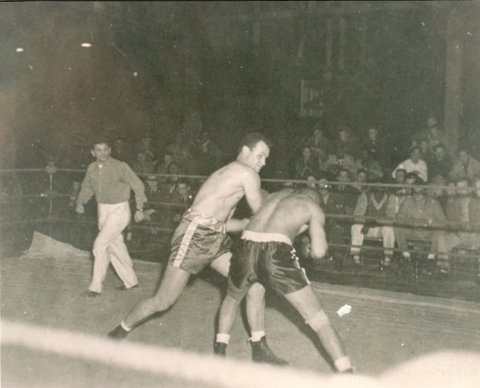by Pax Beale
A guy contacted me about writing a book about boxing history, and sought some unique photos of me. Another guy wanted some photos for a display he was assembling. Why, I’m not certain. I’ve attached a couple, added some Sophie shots, and thrown in some bodybuilding shots, too.
UC Berkeley photo 1951 ( I was 21 years old):

Boxing photo 1952 (I’m winning the U.S. Air Force Boxing Championship. No, he didn’t get up!):

This letter had low priority in our typing pool and it just came back to me for approval. Now that I see it, I kind of forget why I added all the cc’s. There seems to be a disconnect between the origin of the request and those who for some reason I elected to cc. Notwithstanding, there must have been some connection at the time I wrote this, so you get a copy whether you want it or not!
Intercollegiate boxing started off as the “manly art of self-defense,” and then it became a farm system for professional boxing. Small schools took to boxing big time, because they were getting “murdered” in football and basketball, etc. It was expensive to field good teams in those sports, just like today. College boxing was low cost, and small schools saw boxing as a method of being able to compete against major schools and beat them.
At that time the powerhouses were Idaho State in Pocatella, Gonzaga in Spokane, San Jose State, etc., and here in the west they enjoyed beating the hell out of University of California, Stanford, etc.
Then, a guy from the University of Wisconsin got killed in the ring, and “bingo,” all the schools ran from the sport. Boxing was ostracized from the collegiate scene and reverted back to being a sport for minorities and the underprivileged. Every big city had some down and dirty gym filled with those with big dreams, little education, and less hope.
When I fought at Idaho State, they had three guys who made the 1952 Olympic Team (one got the gold) and all turned pro. Two fought for pro world titles. The third (the only guy to beat me) got the gold, turned pro, was undefeated until he lost in his eleventh fight, and died at 2:36 a.m. the next morning in the hospital.
I would fight at UC Berkeley and 250 fans would show up. I’d go to Idaho State, and 9000 fans showed up with standing room only.
It was the “little schools’ day in court” to beat Cal, when they could not even field a team against UC in football.
Those were the days, my friend, and we thought they would never end.
Today, the boxers are bigger, better, faster, and stronger. We wouldn’t be beaten today, we’d be slaughtered; but then every era has its calling.
